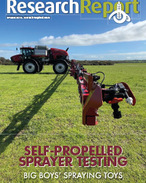This article is 8 years old. Images might not display.
Growers from Geraldton to Esperance, particularly in north-eastern and eastern areas of the WA grainbelt, are advised to monitor crops this spring for signs of pest activity and damage and undertake control measures if incidence reaches threshold levels likely to cause economic losses.
With Grains Research and Development Corporation (GRDC) investment, Department of Primary Industries and Regional Development (DPIRD) researchers, volunteer growers and consultants have been checking pheromone traps for Native budworm moth right across the grainbelt since early August.
This is part of a program to monitor potential risks of the Native budworm to canola and pulse crops.
Latest data from the traps can be found via the GRDC-DPIRD Pestfax and Pestfax Maps services at: https://tinyurl.com/yan5gjw6 and DPIRD Native budworm newsletter at: www.dpird.com.au (search ‘native budworm’).
DPIRD entomologist Svetlana Micic has been out and about checking traps and outlines tips for control of Native budworm in canola and latest research into this pest in a new GRDC ‘Know More’ video.
Accessed at https://youtu.be/pRfOzNyGJMc, this resource provides practical advice about monitoring and managing Native budworm in WA.
More information about Native budworm control and links to industry resources is also available in the GRDC’s GrowNotes™ Canola online resource for the western region HERE.
NATIVE BUDWORM RISK AND INCIDENCE
Native budworm moth flights are variable and unpredictable in WA, but if wind conditions are conducive, the pest arrives in the grainbelt from pastoral areas.
The moths typically prefer to land in flowering crops and tend to either lay eggs or feed on flower nectar and mate before becoming fertile.
Eggs laid by moths at this time of the year will take at least two weeks to grow to about five millimetres in length, at which stage they can be detected using a sweep net.
Svetlana said canola crops are most at risk during flowering (attracting the moths) and as the crop nears maturity and begins to hay-off. Caterpillars of all sizes will enter pods at this stage, with larger caterpillars doing the most damage.
She said trapping provides only an indication of the pests’ activity and cannot be relied on for control decisions.
“Only the use of a sweep/insect net to regularly check crops can give growers confidence in the levels of budworm caterpillars present,” she said.
MONITORING CROPS
Svetlana advises to look for caterpillars up to 40mm in length that are orange, brown and green and tend to have a dark stripe along the body. Photographs and more diagnostic information is available on the GRDC-DPIRD MyCrop website at: https://tinyurl.com/y6weuzud.
It is recommended to monitor crops from the flowering stage for Native budworm incidence, but decisions about control will come later when leaf drop occurs and the crop is at full pod maturation.
Svetlana said this is because the Native budworm can still feed on the pods – even when crop is swathed and cause damage.
“This will occur if the crop is swathed when many pods are still green with soft seed,” she said.
“Seed damage from Native budworm increases in swathed crops if drying is prolonged due to cool damp conditions.”
Svetlana recommends regularly checking Pestfax and Pestfax Maps to see where Native budworm moth flights have occurred and then sweep-net crops near those areas.
She said for WA grainbelt conditions, the best bet is to take 10 sweeps using an insect sweep net in a two metre arc in at least five locations in the paddock.
“Sweep-netting is most efficient in short and thin crops and less efficient in tall dense crops,” she said.
“Key to success is to keep the lower leading edge of the sweep net slightly forward of the net opening so that dislodged grubs are picked up and carried into the net.
“Insecticide decisions can be made by calculating the average number of larvae per 10 sweeps and comparing this with economic thresholds.”
ECONOMIC THRESHOLDS FOR CONTROL
This will depend on pest incidence, costs of control, expected crop yield and grain prices.
More than 90 per cent of Native budworm damage is caused by larvae nearing maturity (between 30 and 40mm in length) and (if numbers exceed thresholds), treatment should occur before they reach this size.
Svetlana said growers and advisers are encouraged to calculate their own control threshold levels, substituting individual control costs (chemical and application) and expected grain prices.
A simple formula that can be used is: economic threshold (ET) = C ÷ (K x P)
C = control cost: chemical + application costs ($/ha).
K = kg/ha eaten for every one caterpillar netted in 10 sweeps or per square metre.
P = price of grain per kg (price per t ÷ 1000)
Detailed information on thresholds can be found HERE.
In WA, research carried out by DPIRD with GRDC investment indicates that for a canola crop with an expected average yield of 2.7 tonnes/ha, it is worth controlling Native budworm if there are six caterpillars/grubs per 10 sweeps when canola has finished flowering and pods are mature. (Based on a grain price of $270 tonne and control costs of $10/ha)
Svetlana said if caterpillar numbers are below the threshold levels, the decision to spray can be delayed and periodic sampling continued.
She said if an insecticide is used, it can be beneficial to continue monitoring crops with a sweep net to confirm the required level of control has been obtained.
CONTROL OPTIONS
Typically, one well-timed insecticide application will achieve effective control for Native budworm if economic thresholds are reached.
Svetlana advises that, where needed, aerial application will do less damage to canola crops and it is important to use registered products at label rates, rotating active ingredients between seasons.
Research and experience in WA shows effectively-applied synthetic pyrethroids (SPs) will prevent re-infestation of Native budworm for up to six weeks after spraying and subsequent caterpillar hatchings will typically be too late to cause any yield damage.
Svetlana said where SPs have used earlier in the season (for other pests), it is best to consider an alternative insecticide to help manage long-term risks of potential insecticide resistance in Native budworm and other insect.
More information about registered insecticides for Native budworm control in WA can be found through the Australian Pesticides and Veterinary Medicines Authority (APVMA) at: https://portal.apvma.gov.au/pubcris
RESEARCH INNOVATIONS IN NATIVE BUDWORM MONITORING
DPIRD researchers, with GRDC investment, are regularly travelling to and manually checking Native budworm traps across the grainbelt this spring.
They are also trialling new ‘smart traps’ that can be monitored remotely every day to provide additional data for industry forecasts and alerts.
Several types of these automated devices, including one being developed by DPIRD with Boosting Grains investment, have been erected on properties around Geraldton, Northam, Merredin and Katanning and are being assessed for effectiveness at monitoring Native budworm moth and diamondback moths (DBM).
DPIRD development officer Christiaan Valentine is leading this research and said the traps work by using a pheromone lure that directs flying moths to the trap or a ‘zapper’ where the moths are captured, imaged and automatically counted.
He said the devices send him high resolution images of the captured moths caught using the mobile network, which can be checked using a mobile phone, computer or tablet.
“The DPIRD trap prototype being developed is a simple design that uses a small circuit board to operate a camera that takes images of moths as they fall into the trap,” he said.
“The images help to identify the pest species and potential population size to alert growers and advisers if insects are flying into crops in the local area – without physically having to go out and check the traps.”
GRDC Project Codes:
CSE00054, DAW00177
Contact:
Svetlana Micic, DPIRD Albany
08 9892 8444
svetlana.micic@agric.wa.gov.au























